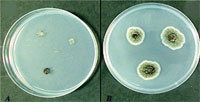

Carotenoid in a fungi keeps heart diseases, cancer at bay


 FED up of popping pills to lower your blood cholesterol? There’s good news as researchers have found a natural way of controlling it.
FED up of popping pills to lower your blood cholesterol? There’s good news as researchers have found a natural way of controlling it.
A research team at the Mysore-based Central Food Technological Research Institute (CFTRI) has isolated a carotenoid, a pigment molecule, from a fungus used in food industries. Carotenoids, also found in carrots and cereals, can lower the levels of cholesterol that triggers cardiovascular diseases. It can also stop the activity of reactive oxygen species (ROS) that damage cells triggering cancer. This led researchers to find carotenoids with similar benefits from bacteria, fungi and yeast and use it for commercial production. They stumbled upon it while trying to increase the yield of pectinase, an enzyme used in food industries. When they cultured wild strain of the fungus Aspergillus carbonarius and exposed it to ultraviolet rays, the fungus produced a mutant strain.
Grown in acidic medium, the strain started to accumulate a yellow pigment alongwith pectinase. Biochemical tests revealed the pigment was a partially saturated carotenoid called Canthaxanthin.
In a previous study, the researchers had found that Canthaxanthin can kill prostate cancer cells. Thus they derived that the carotenoid can stop the activity of ROS which are linked to cancer.
Subsequently, they conducted studies to find the carotenoid’s ability to lower cholesterol and counter the harmful effects of ROS. Mice grown on high fat diet were fed with diets constituting varying concentrations of the carotenoid—50 parts per million (ppm), 100 ppm and 250 ppm. The carotenoid decreased the concentrations of blood and liver cholesterol. In addition, the activity of enzymes, which destroy ROS, increased.
“The study reveals the carotenoid is thermally stable and can help keep ROS-mediated diseases, including cancer, at bay,” says lead researcher Vijayalakshmi Govindaswamy of CFTRI. The study was published in the December 2011 issue of Food and Chemical Toxicology.
We are a voice to you; you have been a support to us. Together we build journalism that is independent, credible and fearless. You can further help us by making a donation. This will mean a lot for our ability to bring you news, perspectives and analysis from the ground so that we can make change together.

Comments are moderated and will be published only after the site moderator’s approval. Please use a genuine email ID and provide your name. Selected comments may also be used in the ‘Letters’ section of the Down To Earth print edition.